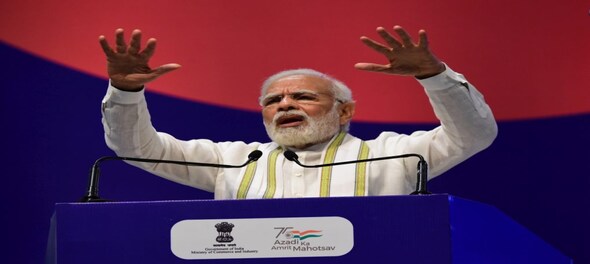
Is Mandal dead? This is a question that has bothered many in the past few years, as the BJP has been winning one election after another.
The BJP’s Parliamentary Board is the latest top body to see an increase in representation from the reserved categories. This follows a similar process seen in expansions of Councils of Ministers and in candidatures for the posts of President and Vice-President.
However, the academic commonsense is that Mandal may well be dead, as parties speaking for OBCs are not winning elections. The JD (U)-RJD government just formed in Bihar is being seen as a feeble, and perhaps temporary, Mandal arrangement.
However, Mandal isn’t dead. It has got wedded to Hindutva in large swathes of north and western India around the personality of Narendra Modi, an OBC leader from Gujarat.
Many, however, do not see Modi as characteristically OBC. They say that he rarely asserts his caste identity and, thus, is primarily only a Hindutva leader.
Christophe Jaffrelot has actually been arguing in his columns that the upper castes have returned, as it were. Herein lies a classic fallacy of observers.
For, what we see today is the normalization of Mandal as an idea. From being an idea valued by a pressure group against the ‘upper castes’, Mandal has become a new normal, as the OBCs have not just empowered themselves but also occupied the driver’s seat in Indian politics.
Also Read | Gadkari, Fadnavis praise new Mahrashtra BJP chief, hail party for rewarding sincere workers
The hegemony of the “upper castes” in Indian politics was largely a feature of the heyday of Congress. The country saw many Prime Ministers from Brahmin backgrounds and two who were Thakurs. When the BJP first came to power in 1998, its composition also showed upper caste hegemony.
However, the post-Vajpayee BJP took a decisive OBC turn. The OBC outreach had begun in the days of KN Govindacharya itself, but the post-Vajpayee years saw OBC leaders like Narendra Modi, Shivraj Singh Chouhan and Sushil Modi as faces of the party in states where it generally did well.
The process intensified with the rise of Modi on the national stage. However, intensification also led to its becoming less vocal.
This is the very nature of hegemony. When it battles a hegemony, a social constituency is assertive and vocal. When it starts occupying a hegemonic space, it is less vocal, as it begins to speak for society at large.
The Congress of the 1960s or 70s did not explicitly speak of caste. It was the Lohia socialists who spoke of the backward castes at that time. Yet, through meticulous research, Jaffrelot showed in his book India’s Silent Revolution that in Uttar Pradesh, the largest state in terms of population, the Congress had a heavy Brahmin presence.
The rise of the OBCs in north India since the late 1960s was taken as the deepening of democracy by many observers. By the turn of 1990, this rise of OBCs had acquired a powerful performative dimension that challenged the “upper castes”. One still remembers the controversy over Lalu Prasad’s purported slogan: ‘Bhura Baal Saaf Karo’ (Remove the grey hair, an acronym for Bhumihar, Rajput, Brahmin, and Lala, meaning Kayastha in Bihar).
This marked the moment of transition, and polarized society around caste. The “upper castes” felt unsettled for the first time in north India and rising OBC leaders spoke the language of social rebels, consciously breaking even with the sophisticated Hindi many “upper caste” leaders had spoken for decades.
What one sees today is an altered scenario. We have an OBC Prime Minister and Vice-President. Two of the three top constitutional positions are in the hands of OBCs. The “upper caste” Cabinet Ministers do the work assigned to them but aren’t assertive within the BJP. Nitin Gadkari, the only one who spoke out of turn sometimes, is out of the BJP Parliamentary Board.
A rising and assertive state leader from the “upper castes”, Yogi Adityanath, has not been able to join the Parliamentary Board, which has seen the induction of Sudha Yadav and K Laxman, both OBC. In a caste balancing act, Satyanarain Jatiya, a Dalit, and Sarbananda Sonowal, a tribal, have also been inducted. Significantly, Shivraj Singh Chouhan, an OBC who once saw himself as competing with Modi, has been replaced by Jatiya, a Dalit from MP.
Yet, there is no talk of OBC assertion or of ‘de-Brahmanisation’ of the BJP.
The BJP of today is an OBC party just as the Congress of the 1960s and 70s was an “upper caste” party. But, since the power structure is established and not immediately open to negotiation, the party talks the language of ‘the nation’ and not of caste.
Mandal isn’t dead. It has become the new normal, and thus speaks for the larger collective rather than just OBCs.
Each group that occupies power gradually sheds the language of assertion of identity and speaks for the nation. The one who can claim to speak most comfortably for it and gets heard is the hegemon.
At present, it is only Narendra Modi, by birth a Modh-Ghanchi from Gujarat but by function the spokesman of India for millions of voters.
(Vikas Pathak is a columnist and a media educator).
(Edited by : Abhishek Jha)
First Published: Aug 20, 2022 2:04 PM IST
Check out our in-depth Market Coverage, Business News & get real-time Stock Market Updates on CNBC-TV18. Also, Watch our channels CNBC-TV18, CNBC Awaaz and CNBC Bajar Live on-the-go!


BJP is planning to ban RSS, says Shiv Sena (UBT) chief Uddhav Thackeray
May 18, 2024 8:01 PM
Punjab Lok Sabha elections: Complete list of Congress candidates
May 18, 2024 4:08 PM
Punjab Lok Sabha elections: Check full list of AAP candidates and constituencies
May 18, 2024 12:59 PM
PM Modi, Rahul Gandhi election rallies in Delhi today: Here are the routes to avoid
May 18, 2024 11:28 AM

